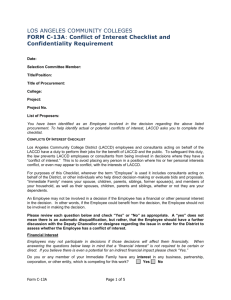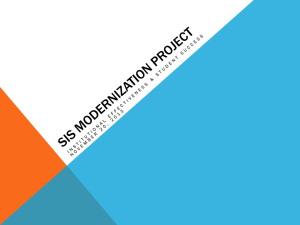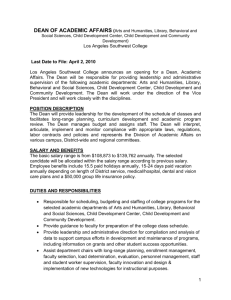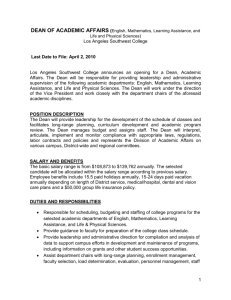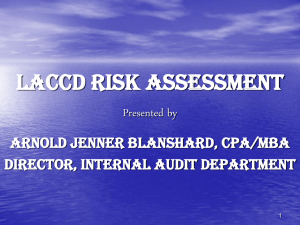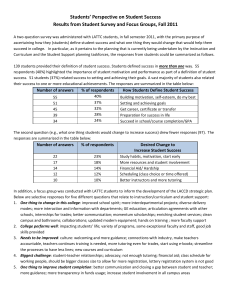LACCD Technology Plan
advertisement
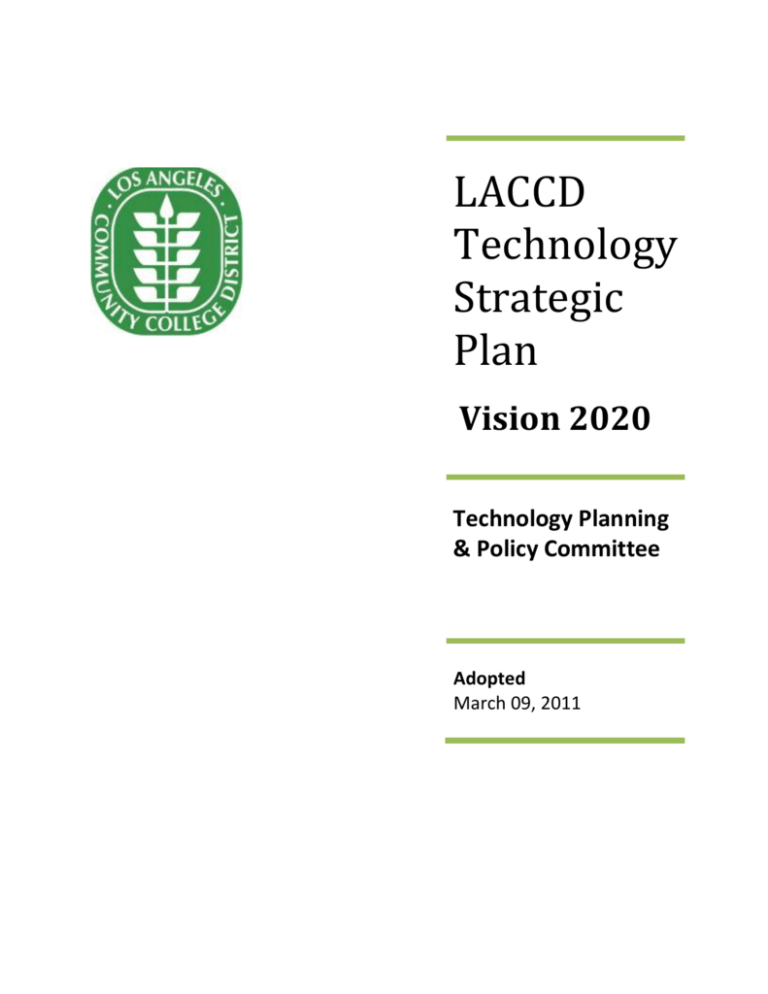
LACCD Technology Strategic Plan Vision 2020 Technology Planning & Policy Committee Adopted March 09, 2011 LACCD – Technology Plan 2 Table of Contents 1. Executive Summary 03 2. Introduction 05 3. District Technology Planning Taskforce 06 4. LACCD Technology Vision, Mission, and Shared Values 07 5. Student Success Powered by Technology 08 6. Internal Environmental Analysis 09 7. External Environmental Analysis 11 8. Technology Enhanced Learning Environments 12 9. Guiding Principles 13 10. Learning 14 11. Assessment 15 12. Teaching 16 13. Infrastructure 17 14. Productivity 19 15. Appendix 20 Technology Planning and Policy Committee LACCD – Technology Plan 3 Executive Summary The LACCD Technology Plan has been created to meet the learning needs of students in the 21st Century. The plan integrates technology into learning, teaching, and student learning outcomes in alignment with the 2010 National Educational Technology Plan. To fulfill these goals, in March 2010, the LACCD convened a Technology Planning and Policy Committee (TPPC) to coordinate the activities of a number of district-level technology-related advisory groups and to provide a forum for consolidation of all technology-related issues. A participatory governance committee, the TPPC was tasked with developing a comprehensive technology plan to identify districtwide technology needs over the coming decade. The TPPC formed a Districtwide Technology Planning Taskforce (DTPT) comprising of faculty from each of the nine colleges, administrative leadership, and students to accomplish this task. The taskforce met several times and created the following draft plan, which includes a Mission and Vision statement and is based on the following key assumptions: Students today learn differently than in years past; and technology can help provide diverse learning experiences. Delivering engaging learning experiences and resources for all learners, anytime and anywhere requires state of the art technology with specialized processes, tools and support staff. Leveraging the potential of technology will continuously improve learning outcomes while increasing productivity at all levels. Upon adoption (following LACCD governance process), this document with a 10-year horizon, will be used to create an implementation plan with metrics. The implementation plan will help prioritize deployment of various solutions as resources become available. The technology plan will be a living document that will be reviewed and updated annually, and reassessed in five years. This plan will inform the individual college technology plans and serve as a guide to ensure connectiveness across the colleges. The LACCD proposes to be at the forefront of innovation among community colleges in integrating technology, educational access and opportunity for students across its nine colleges. The mission of LACCD’s technology plan is to offer students an information-rich interactive educational environment that integrates technology into the fabric of learning experiences and provides students with the connectivity, access, information, tools, and services they need to accomplish their goals. Technology Planning and Policy Committee LACCD – Technology Plan 4 To achieve this mission, technology at LACCD will build upon the dual values of LACCD: Focus on students Data driven continuous improvement The DTPT identified five key areas to achieve the mission of providing an information-rich, interactive educational environment that integrates technology into the fabric of teaching and learning experiences: Learning – The LACCD will leverage powerful technology that provides personalized learning that customizes the pace of teaching and instructional practices. All learners will have engaging and empowering learning experiences both in and outside of college classroom that prepare them to be active, creative, and knowledgeable participants in a globally networked society Assessment – The LACCD will leverage technology to regularly measure and report student success, institutional effectiveness, and operational efficiency while using assessment data for continuous improvement Teaching – The LACCD will increase the ability of educators to use technology to create engaging, meaningful and connected learning environments. They will be supported individually and in teams by technology that connects them to data, content, resources, expertise, and learning experiences that enable and inspire more effective teaching for learners Infrastructure – The LACCD will provide a comprehensive sustainable technology infrastructure including hardware, software, support staff, policies, and processes for students, educators, and staff for learning when and where needed Productivity – The LACCD will redesign organizational processes and structure to take advantage of technology in order to improve learning outcomes and use resources more efficiently Goals in the five areas will be implemented with a focus on the plan’s guiding principles that include a focus on total cost of ownership, integrating systems to enter data once for multiple uses, with adaptable and scalable systems that can accommodate changing needs using open industry standards. LACCD will encourage, value and support the use of technology by faculty, staff and students to achieve their educational and professional goals. Technology deployments will be aimed at fulfilling student needs with educators supporting these needs, while investing capital to contain operating costs. Technology Planning and Policy Committee LACCD – Technology Plan 5 Introduction The LACCD convened the Technology Planning and Policy Committee (TPPC) to coordinate the activities of a number of district-level technology-related advisory groups and to provide a forum for consolidation of all technology-related issues in March 2010. A participatory governance committee, the TPPC was tasked with developing a comprehensive strategic technology plan to address future district-wide information technology needs. The TPPC serves as a clearing house for all policy issues related to district-wide technology systems. It aligns the planning and policymaking activities of a number of Districtwide groups that had previously operated without formal coordination. The TPPC formed a Districtwide Technology Planning Taskforce (DTPT) comprising of faculty representing each of the nine colleges, administrative leadership, and students to accomplish this task. The taskforce met several times over an eight-week period and created the following draft plan, which was reviewed and modified by the TPPC and was presented for consideration by various LACCD constituents. It was unanimously approved by the TPPC on November 16, 2010. Upon adoption (following LACCD governance process), this document with a 10-year horizon to 2020, will be used to create an implementation plan with metrics. The implementation plan will help prioritize deployment of various solutions as resources become available. The technology plan is a living document that will be reviewed and updated annually and reassessed in five years. This plan will inform the individual college technology plans and serve as a guide to ensure connectiveness across the colleges. The LACCD is the largest community college district in the United States. It is dedicated to preparing students for an increasingly diverse and technological world, whether seeking careers that enhance their quality of life, through good jobs and higher earning power, or preparing for transfer to four-year degree colleges. In alignment with the District’s vision and mission, the LACCD’s technology plan will be at the forefront of innovation among community colleges. It visualizes integrating technology, educational access and opportunity for students across its nine colleges. In alignment with the National Education Technology Plan, it strives to provide all students with the technological environment that allows for engaging and empowering learning experiences. The LACCD Technology Plan builds on its dual values of focusing on students and data driven continuous improvement. Its mission is to offer students an information-rich, interactive, educational environment that integrates technology into the fabric of learning experiences and to provide students with the access, connectivity, information, tools, and services they need to accomplish their goals. Technology Planning and Policy Committee LACCD – Technology Plan 6 District Technology Planning Taskforce The District Technology Planning Taskforce wishes to acknowledge the following taskforce participants for their dedication and efforts in creating this Technology Strategic Plan in a very short duration. Wendy Bass Adriana Barrera John Clerx Gary Colombo Marcus Butler Ivan Clarke Linda Delzeit Marcy Drummond Deborah Harrington David Jordan Monica Martinez Jorge Mata Paul McKenna Joseph Perret Michael Rendler Jorge Reyes Frank Santano Amy Sirott Rebecca Tillberg Bradley Vaden Co-Chair, Faculty, ELAC Co-Chair, Deputy Chancellor Vice Chancellor Vice Chancellor Faculty, WLAC Director, CIS - LAHC Faculty, LATTC VP, Workforce Development - LATTC Dean of Student Success Faculty, LAMC District office Chief Information Officer Director of ITV Faculty, LAPC E7 Studios and Faculty, LATTC Student Representative Student Representative Faculty, LAPC Researcher, WLAC Faculty, LATTC Facilitators – CFM Group Inc Subodh Kumar Akhilesh Gulati Teresa Romney Technology Planning and Policy Committee LACCD – Technology Plan 7 District Technology Vision, Mission and Shared Values The DTPT reviewed the LACCD Vision and Mission and the 2010 National Education Technology Plan which were used to create the LACCD Technology Vision, Mission and Shared Values as detailed below: Vision The LACCD proposes to be at the forefront of innovation among community colleges, integrating technology, educational access and opportunity for students across its nine colleges. Mission The mission of LACCD’s technology plan is to offer students an information-rich interactive educational environment that integrates technology into the fabric of learning experiences and provides students with the connectivity, access, information, tools, and services they need to accomplish their goals. Shared Values To achieve this mission, technology at LACCD will build upon the dual values of LACCD: Focus on students Data driven continuous improvement Technology Planning and Policy Committee LACCD – Technology Plan 8 Student Success Powered by Technology The purpose of the LACCD Technology Plan is to meet the learning needs of students in the 21st Century. In alignment with the 2010 National Educational Tech Plan, it integrates technology into learning, teaching, and student learning outcomes. The LACCD is a complex organization with nine colleges throughout Los Angeles County serving over 200,000 students every year, facing similar and nuanced challenges in an environment where technological advances are taking place at an increasingly fast pace. Students live in a world where access to information and resources is 24-7. This requires that competing technology needs are carefully evaluated and deployed to ensure not only that students are fully engaged in college, intellectually, socially and emotionally, but also to optimize the investment of limited resources with a life-cycle perspective. The Plan is based on the following key assumptions: Students today learn differently than in years past; and technology can help provide diverse learning experiences. Delivering engaging learning experiences and resources for all learners, anytime and anywhere requires state of the art technology with specialized processes, tools and support staff. Leveraging technology will continuously improve learning outcomes while increasing productivity at all levels. Technology Planning and Policy Committee LACCD – Technology Plan 9 Internal Environmental Analysis The Educational Services Center (District Office) provides support for Districtwide technologies including hosting and supporting the Student Information System (SIS), and an Enterprise Resource Planning System (SAP) for Financials, Accounting, Human Resources, Procurement, and a number of administrative systems. Plans for other functions to be incorporated include Asset Management, Budget formulation and a comprehensive Maintenance Management System for facilities and technology support. Colleges differ in their technology planning and operating models. They differ in their organizational structures for implementing information technology and staffing. College related technology services are housed in a college controlled data facility with varying levels of equipment, resilience, power, cooling and backup systems. Some have more than one data facility, while most have only a single location. Disparate systems and equipment deployed at each college and across the colleges hinder consistency, interoperability and support with limited staffing and support. Technologies being deployed span multiple job functions. Staff positions and skill sets need to be updated and enhanced through realignment and training. Such autonomy has led to disparate levels of quality of support, duplication of effort across the district, and difficulty in ensuring compliance with policies and state or federal mandates. Duplication of effort is especially true where colleges tend to implement tools and services that are already, or can be, deployed Districtwide, such as a single identity management solution, comprehensive student email and services management. In addition, a college may make decisions that affect another college or have an impact across the district. As education becomes more technology dependent, there is increasing need for skill sets and training of staff in the rapidly changing environment. Further, newer facilities are equipped with sophisticated Energy and Building Management systems that require access by a variety of service providers, while protecting the college networks. Since 2009, LACCD has engaged in an effort to accelerate the development of Districtwide minimum standards for infrastructure, cabling, data center location, sizing and environments for technology support. Further, standards for applications, web portals, and smart classrooms have also been developed – all of which collectively provide open architecture standards defining performances to industry protocols for interoperability, with great flexibility of products that meet the needs of each situation and college. Technology Planning and Policy Committee LACCD – Technology Plan 10 The district has undertaken the development of a high-speed Districtwide fiber network, a wireless blanket over each college, and supporting resilience across the colleges. This network will allow data facilities to provide distributed services across the District. LACCD has initiated an upgrade of its student information system (SIS) and has determined that an off-the-shelf SIS that will meet the emerging needs of the entire LACCD, and operationalize connections to existing systems where feasible. A guiding principle of this effort has included the creation of functional maps. These maps have also been used for optimizing various functions that bring commonality across the colleges for the variety of SIS functions, and to collect information once that can be used multiple times with “mass customization” for students, educators and administration. Technology Planning and Policy Committee LACCD – Technology Plan 11 External Environmental Analysis An external environmental analysis over the past few months revealed a series of directions being pursued by various academic institutions of higher learning, which were considered by the DTPT, some of which are summarized below. The National Educational Technology Plan 2010 states that technology-based learning and assessment systems will be pivotal in improving student learning and generating data that can be used to continuously improve the education system at all levels. Technology will help execute collaborative teaching strategies combined with professional learning to better prepare and enhance educators’ competencies and expertise over the course of their careers. To shorten the learning curve, institutions can learn from other kinds of enterprises that have used technology to improve outcomes while increasing productivity. According to EDUCAUSE “Current Issues Survey” of its projected priorities for this decade include administrative/ enterprise resource planning (ERP) information systems, security, infrastructure/cyber infrastructure, teaching and learning with technology, identity/access management, governance agility and learning management systems. The 2010Horizon Report lists the following key trends: Revisiting roles with educators Student expectations of learning whenever and wherever Cloud-based technologies (hosted services) IT support based on cloud computing Increasing student and campus department collaboration Technology Planning and Policy Committee LACCD – Technology Plan 12 Technology Enhanced Learning Environments The DTPT identified five areas to achieve the LACCD mission of providing an information-rich, interactive educational environment that integrates technology into the fabric of teaching and learning experiences: Learning Assessment Teaching Infrastructure Productivity Technology Planning and Policy Committee LACCD – Technology Plan 13 Guiding Principles 1. LACCD will foster an environment where educators, staff and students can readily access and use information they need to accomplish their professional and educational goals. 2. LACCD will implement adaptive and scalable systems that can accommodate changing technology needs, using open industry standards and flexibility for replacing equipment that meets emerging needs rather than being vendor-centric. 3. LACCD will use technology to enhance communication and maintain relationships among its stakeholders. 4. LACCD will value, encourage, and support the use of technology by students, educators, and staff to achieve their educational and professional goals. 5. LACCD’s investments in technology will reflect good stewardship of the resources entrusted to it and make choices with a total cost of ownership model for technology investments. 6. LACCD will strive to deliver consistent, high-quality technical support to students, educators, and staff meeting their diverse and unique needs. 7. LACCD will endeavor to implement and maintain technology systems that safeguard the entire district's data and ensure the confidentiality of the personal information under its care. 8. Technology will support the continuous improvement of all academic and administrative operations at LACCD, using workflow and automation. Technology Planning and Policy Committee LACCD – Technology Plan 14 Learning The LACCD will leverage powerful technology that provides personalized learning that customizes the pace of teaching and instructional practices. All learners will have engaging and empowering learning experiences both in and outside of the college classroom that prepare them to be active, creative, and knowledgeable participants in a globally networked society. LACCD desires to implement the modes of 21st century learning for engaging and empowering learning experiences. The model focuses on multiple approaches to teaching and learning addressing what and how to teach; matching what people need to know; looking at how, when and why they learn; as well as exploring who needs to learn. It brings state-of-the-art technology into the learning process to enable, motivate, and inspire students to succeed, regardless of background, language, or ability. To meet this goal, the following actions are recommended: Leverage the proposed infrastructure to enable students and educators 24-7 access to ondemand customizable personal learning environments including review of class materials with contextual support from other students and educators Collaborate with California K20 Educational Technology Collaborative initiatives to share appropriate student data across segments (school, community college, graduate and postgraduate) with capability to personalize student guidance Provide capabilities in the SIS to enable real-time student tracking and modeling of courses and activities to goals including entering trades, earning certificates, and transfer to 4-year colleges, as well as contextual assistance from counselors Facilitate contextual on-line guidance for multi-media tools in assisting students and educators Create on-line refresher support for technology learning environments like videoconferencing for teaching, and using smart classrooms and other technology environments across the District Facilitate distributed educational programs that leverage hybrid learning, combining faceto-face and on-line capabilities Develop Industry partnerships that consistently engages potential employers in enhancing skill sets desired in the workplace Technology Planning and Policy Committee LACCD – Technology Plan 15 Assessment The LACCD will leverage technology to regularly measure and report student success, institutional effectiveness, and operational efficiency while using assessment data for continuous improvement. The 21st century learning model requires new and better ways to measure what matters, diagnose strengths and weaknesses during the course of learning to improve student performance, and involve multiple stakeholders in designing, conducting and using results of assessment. In all these activities, technology-based assessments can provide data to drive decisions on the basis of what is best for each and every student that in aggregate will lead to continuous improvement across the LACCD. To meet this goal, the following actions are recommended: Create, deploy and maintain a role-based institutional effectiveness “dashboard” reporting system to facilitate fact-based decision making by providing timely data on academic programs, student support services, and institutional efficiency from a common District database Deploy and develop processes for the use of systems and tools that facilitate planning, goal setting, self-assessment and self-improvement for all LACCD students, educators and staff (“LifeMap”) Provide data management systems to assist in the tracking and reporting of institutional effectiveness processes, including those associated with student learning outcomes assessment, accreditation reporting, program review, and educational planning Ensure availability of appropriately skilled technology support that can provide guidance with assessment tools for students and educators Provide professional development to increase the technological capacity to use data for assessment Technology Planning and Policy Committee LACCD – Technology Plan 16 Teaching The LACCD will increase the ability of educators (including faculty, staff & administrators) to use technology to create engaging, meaningful and connected learning environments. Educators will be supported individually and in teams by technology that connects them to data, content, resources, expertise, and learning experiences that enable and inspire more effective teaching for learners. 21st century learning requires using technology to help build the capacity of educators by enabling a shift to a model of connected teaching. In such a teaching model, teams of connected educators replace solo practitioners and classrooms are fully connected to provide educators with 24-7 access to data and analytical tools, as well as to resources that help them act on the insights provided by the data. To meet this goal, the following actions are recommended: Leverage the proposed infrastructure to create a Districtwide repository of teaching tools like reusable learning objects, educational video, music, and mobile access tools – supported by contextual on-line support services Link course management system(s) to the new SIS and minimize non-value added activities in creating access and support for administrative tasks Create an interactive electronic grade book connected to SIS Provide consistent plug-ins and templates with intuitive and simple tools to assist educators in using newer technologies Guide educators in using web-enhanced assignments and syllabi for students Create forums for educators networking across disciplines and colleges Formulate a support system of students/ educators for integration with interactive multimedia capabilities and assistance in instructional design (mentor/ mentee program) Develop technology proficiency certification program to enhance technology use by educators, creating centers for instructional technology supported across the district Offer incentives for incorporating use of technology in enhanced Smart classrooms Maintain appropriate versions of software with districtwide licensing to prepare students with emerging needs of the marketplace Provide on-line technology support for educators and students Technology Planning and Policy Committee LACCD – Technology Plan 17 Infrastructure The LACCD will provide a comprehensive sustainable technology infrastructure including hardware, software, support staff, policies, and processes for students, educators, and staff for learning when and where needed. An essential component of the 21st century learning model is a comprehensive infrastructure that provides all students, educators and staff with the resources when and where they are needed. Infrastructure includes people, processes, learning resources, policies and sustainable models for continuous improvement in addition to broadband connectivity, servers, software, management systems and administration tools. Building this infrastructure is a far-reaching project that will demand a concerted and coordinated effort. To meet this goal, the following actions are recommended: Implement an integrated Student Information System (SIS) that utilizes self-service for students, faculty and staff, collects information once, utilizes automated work-flow and common business processes, and addresses the changing life-cycle needs of the various constituencies across the LACCD with information flow between the colleges and the District Office Deploy an LACCD communications portal, and electronic portfolio tools that provide a consistent means of communicating with students, educators, staff and the community Develop an LACCD-owned high-speed fiber-optic network connecting all colleges and satellite locations to link academic information, technology systems, and administrative support systems Provide a high-speed wireless access system covering all colleges with an extended range around them for use by registered students, educators and staff for academic purposes Create smart classrooms across the LACCD colleges that provide consistent and easy to use interface with flexible and scalable infrastructure to meet changing needs Implement districtwide network and physical security systems that protect legitimate users from breaches, while balancing academic needs. Create technology business continuity and emergency management systems to provide data integrity, data backup, and resilience in the event of mishaps from nature, technical failures or those caused by human error Deploy a single password access for districtwide systems that simplifies accessibility to appropriate data and information for students, educators and staff Implement integrated facilities technology systems that allow for management and optimization of energy usage, building systems connected to geographic information, maintenance management systems, and access controls Technology Planning and Policy Committee LACCD – Technology Plan 18 Adopt standardized replacement cycle for hardware and software that appropriately supports emerging technologies and needs Conduct a periodic review of technology programs district wide to identify gaps in staffing levels, skills, and functional roles with emerging technology solutions, supported by appropriate training for users and technology staff Technology Planning and Policy Committee LACCD – Technology Plan 19 Productivity The LACCD will redesign organizational processes and structure to take advantage of technology in order to improve learning outcomes and use resources more efficiently. To achieve the goal of transforming education, basic assumptions will be challenged to streamline organizational processes that remove duplication of work at all levels and deploy automation to create a more effective organization, and education system. LACCD will redesign processes and structures that leverage the power of technology to improve learning outcomes, while making more efficient use of time, money, and staff. To meet this goal, the following actions are recommended: Foster a culture to encourage organizational change. Provide ongoing support and training for district personnel to facilitate use of newer technologies Adopt business processes using technology solutions that distribute the workload and automate workflow, thereby increasing staff productivity, reducing the use of paper and eliminating the need for lines Standardize educational learning support tools such as procuring educational and learning accounting tools that can be used across the district Adopt a technology deployment model that considers total cost of ownership, leveraging district size in procuring hardware, software and configuration services Provide interoperable, customizable, integrated and transportable systems for: o Training o Electronic transcripts o Electronic grade-books o 24-7 technology helpdesk Adopt a culture of evidence-based decisions including appropriate certifications Implement a districtwide system for deploying/ managing technology projects Create a culture of continuous scanning for emerging technologies Foster a dialog to revise incentive structure for continuous technology skills enhancement for educators (including faculty, staff and administrators) Technology Planning and Policy Committee LACCD – Technology Plan 20 Appendix The following documents are referenced sources, copies of which are available: 1. Educause Learning Initiative: Horizon Report, 2010 Edition 2. Educause: IT’s decade of “Current Issues Survey” 3. Transforming American Education: Learning Powered by Technology: Draft National Educational Technology Plan 2010 Executive Summary, March 5, 2010 Office of Educational Technology, U.S. Department of Education Technology Planning and Policy Committee

